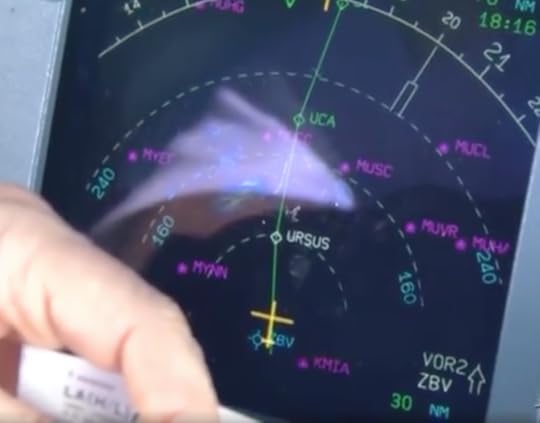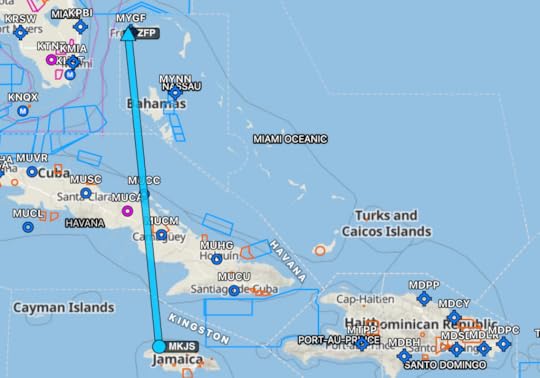The Bus to Montego Bay, Jamaica

Below, I’ve linked a good video presentation of a 2009 Air Canada A321 flight into Sangster International airport at Montego Bay, Jamaica.
I flew that route many times. I would have loved to have stayed in Jamaica for more than the one hour turn-around time.
A couple of points about the video:
The arrival to Jamaica crosses Cuban airspace. That was always “interesting” because our route charts carried warnings that any “unauthorized deviations from the assigned routes could result in military interceptions or…(worse?).” I found Cuban ATC to be friendly and cooperative, but I ALWAYS was very careful to coordinate any required deviations around thunderstorms etc. when in their airspace.
 The captain in the video mentions that the approach this day was not rushed. What often happens on this route is that we can’t get a descent clearance until we transfer out of Cuban airspace into Jamaican. By this time we might already be a bit high for the remaining distance to fly.Then, Jamaican ATC might offer us short cuts from our planned route (depending upon traffic, weather and such). While this saves us time and fuel, it also puts us even higher above the desired profile. Some days this all adds up to a bit more work juggling the automation and the drag devices to manage our altitude and speed properly on the way in.This captain also talks about how the visibility was good this day and they saw the airport from about 15 miles back. This is a bit unusual at MBJ, in my experience. The afternoon clouds and humidity commonly made for ceilings less than 3,000 feet and visibility around a mile or two. In fact, I recall that during my first two or three visits I never actually saw the Island of Jamaica at all! I only saw the approach over the water, then the rising, lush green hills to the south of the airport.As anyone has read my second book knows, I playfully “moan” about how we were required, back in the day, to cross-check the multi-million dollar automation and database tools with our “twenty-five cent” pieces of paper. This 2009 arrival at Montego Bay clearly illustrates that. The Final Legal Authority for the instrument navigation procedures was vested in the paper copies. We pilots had to manually enter all the navigation details and altitudes into the computers and double-check our own accuracy plus the accuracy of any pre-stored (canned) information that was built in to help ease this task.
The captain in the video mentions that the approach this day was not rushed. What often happens on this route is that we can’t get a descent clearance until we transfer out of Cuban airspace into Jamaican. By this time we might already be a bit high for the remaining distance to fly.Then, Jamaican ATC might offer us short cuts from our planned route (depending upon traffic, weather and such). While this saves us time and fuel, it also puts us even higher above the desired profile. Some days this all adds up to a bit more work juggling the automation and the drag devices to manage our altitude and speed properly on the way in.This captain also talks about how the visibility was good this day and they saw the airport from about 15 miles back. This is a bit unusual at MBJ, in my experience. The afternoon clouds and humidity commonly made for ceilings less than 3,000 feet and visibility around a mile or two. In fact, I recall that during my first two or three visits I never actually saw the Island of Jamaica at all! I only saw the approach over the water, then the rising, lush green hills to the south of the airport.As anyone has read my second book knows, I playfully “moan” about how we were required, back in the day, to cross-check the multi-million dollar automation and database tools with our “twenty-five cent” pieces of paper. This 2009 arrival at Montego Bay clearly illustrates that. The Final Legal Authority for the instrument navigation procedures was vested in the paper copies. We pilots had to manually enter all the navigation details and altitudes into the computers and double-check our own accuracy plus the accuracy of any pre-stored (canned) information that was built in to help ease this task. Now-a-days the legal authority and accuracy verification process has also been applied to the eVersions. For a look at how the “paperless” flight deck has progressed – here’s a favourite vLogger I follow.
He’s flying the B737-800(?) which represents a similar level of automation technology as the A320. In the first departure from Phoenix, you can see how the ATC clearances and full company-planned routing is transmitted electronically to the aircraft. (There is definitely a lot of “finger magic” required to make it all happen). In the second departure from Cabo we see that some “old school” practices are still in effect at many ATC centres – and it’s a good demonstration of how human errors occur and how (ideally) they are caught and corrected in that system. (i.e. the ‘read back’ process)



